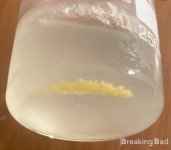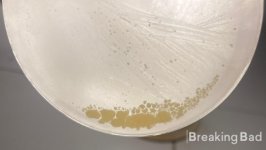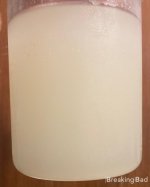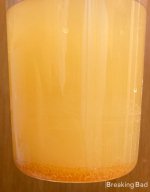- Language
- 🇺🇸
- Joined
- Jan 31, 2025
- Messages
- 2
- Reaction score
- 0
- Points
- 1
Hi!
Attempts at the one-pot Helional to helionamide process, without successful results.
Issues seem to be the same some people encountered, so if you can give some hindsight it’d be greatly appreciated:
- 13,5g hidroxilamine are added to 175ml DMSO, heating and stirring until it’s dissolved (40°C).
- 35g Helional are added, temperature set to 70°C in a water bath (600ml beake covered with plastic wrapping film, automatic temperature control mag-stirring hotplat with the temperature probe in the reaction mixture),then rising it up to 90°C (less than 95°C)and keeping for 90 minutes.
- Let cool to 70°C.
- A soln. made of 7,8g NaOH + 58ml water is added to the beaker, then 2g NaHCO3 suspended in 10ml water. Stuff gets darker and opaque pH is around 9-10 (pH test strips). One run some additional NaOH soln. is added to get to a pH=10 (pH testing strips).
- A soln. made of 125ml 30% H2O2 + 85ml water, freshly prepared and basified to pH= 7,0-8,0 (pH test strips is added with a pipette in 5ml portions every 30 seconds approximately, allowing foaming to stop between additions. Beaker still in water bath, temperature set to 85°C (keeping higher than 80°C but never going up to 90°C). Some exit Hermila and foaming is observed. Some NaOH soln. is required to correct pH up to 10 regularly. When peroxide soln. and NaOH soln. contacts the rxn mixture there seems to be some milky withe stuff forming, and then dissolving, or might be gas developing (volumes are not big enough for foaming). Less than half way through the addition rxn mixture starts getting lighter computed (amber) and less opaque (wouldn’t call it transparent, but there’s vigorous stirring ad micro bubbles though).
- After uncovering and letting everything cool down to 50°C there is an oily layer at the bottom of the beaker (clear, amber), a lighter amber aqueous layer(slightly turbid), and a very thin oily stains at the top.
Extraction with DCM, and evap gives an oily slightly reddish amber stuff.
Attempt to crash in cold water (double or 10 times the sample volume, no difference) gives a milky result, which gives some opaque yellow-whiteish viscous oily like stuff at the bottom when chilled in the freezer.
EDIT: After some advice from other places, rxn mixture was stirred and heated to 100ºC for 30 minutes -> no changes. Also, another similar amount of peroxide was added under the same conditions as the first one, still no changes. (Its possible that this mixture is already f*cked-up, so another fresh run is probably needed, but its important to have some experienced user tips and tricks before wasting more materials.
Currently loosing it, don’t fully understand the difference between what I’ve seen in the forum from other bees who succeded…
Attempts at the one-pot Helional to helionamide process, without successful results.
Issues seem to be the same some people encountered, so if you can give some hindsight it’d be greatly appreciated:
- 13,5g hidroxilamine are added to 175ml DMSO, heating and stirring until it’s dissolved (40°C).
- 35g Helional are added, temperature set to 70°C in a water bath (600ml beake covered with plastic wrapping film, automatic temperature control mag-stirring hotplat with the temperature probe in the reaction mixture),then rising it up to 90°C (less than 95°C)and keeping for 90 minutes.
- Let cool to 70°C.
- A soln. made of 7,8g NaOH + 58ml water is added to the beaker, then 2g NaHCO3 suspended in 10ml water. Stuff gets darker and opaque pH is around 9-10 (pH test strips). One run some additional NaOH soln. is added to get to a pH=10 (pH testing strips).
- A soln. made of 125ml 30% H2O2 + 85ml water, freshly prepared and basified to pH= 7,0-8,0 (pH test strips is added with a pipette in 5ml portions every 30 seconds approximately, allowing foaming to stop between additions. Beaker still in water bath, temperature set to 85°C (keeping higher than 80°C but never going up to 90°C). Some exit Hermila and foaming is observed. Some NaOH soln. is required to correct pH up to 10 regularly. When peroxide soln. and NaOH soln. contacts the rxn mixture there seems to be some milky withe stuff forming, and then dissolving, or might be gas developing (volumes are not big enough for foaming). Less than half way through the addition rxn mixture starts getting lighter computed (amber) and less opaque (wouldn’t call it transparent, but there’s vigorous stirring ad micro bubbles though).
- After uncovering and letting everything cool down to 50°C there is an oily layer at the bottom of the beaker (clear, amber), a lighter amber aqueous layer(slightly turbid), and a very thin oily stains at the top.
Extraction with DCM, and evap gives an oily slightly reddish amber stuff.
Attempt to crash in cold water (double or 10 times the sample volume, no difference) gives a milky result, which gives some opaque yellow-whiteish viscous oily like stuff at the bottom when chilled in the freezer.
EDIT: After some advice from other places, rxn mixture was stirred and heated to 100ºC for 30 minutes -> no changes. Also, another similar amount of peroxide was added under the same conditions as the first one, still no changes. (Its possible that this mixture is already f*cked-up, so another fresh run is probably needed, but its important to have some experienced user tips and tricks before wasting more materials.
Currently loosing it, don’t fully understand the difference between what I’ve seen in the forum from other bees who succeded…




